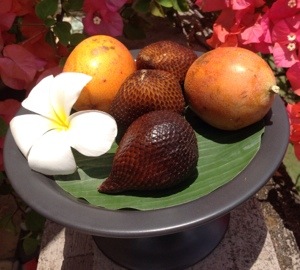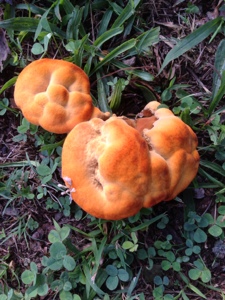
by Loti | Jan 20, 2014 | Animals, Australia, Birds, Endangered Species, Environment, Flowers, Food, Health, Insects, Plants
Adelaide, Australia. Within walking distance of our hotel, I discover a magical botanical garden. Free to the public, in the middle of downtown, this 125 acre oasis includes a rainforest under glass. The forest is housed in the largest single span greenhouse in the Southern Hemisphere (for those of us geography challenged, the Southern Hemisphere is all the land below the equator including Anartica, Australia, most of South America and a third of Africa.) Entering the glass 2 story structure, the air is misty and buzzing with activity, from birds, insects, plants growing and 1,000 misting nozzles. I have always heard how important the rainforest (defined as a dense forest receiving 90-180 inches of annual rainfall) is to our global ecosystem, but I had no idea 50% of the world’s plants and animals live in them. And many of our medicines (some anti cancer and leukemia drugs for starters) come from rainforest plants. Yet we are losing 1-2 (and some biologists estimate the number is closer to 100) animal and plant species a day to extinction primarily from deforestation. Wow! So what can we do? I plan on learning more about the issues and possible solutions by joining a conservation club, visiting rain forests whenever I can and taking steps to recycle and be nice to our Earth. Once a species is gone, we can never get it back. And that sounds so...

by Loti | Jan 2, 2014 | Food, Indonesia
Bali, Indonesia. I am always amazed at how much I don’t know. While I have traveled the world fairly extensively, I always find new fascinating things. Whether 5 miles from home, in my backyard or thousands of miles away, there is a whole world out there if I just pick my head up, look around and be present. Checking into my amazing room in Bali, I couldn’t help but notice a very weird looking fruit on the plate in my room. It was brown with scales and looked like a baby armadillo. Do you eat this thing, I wondered? Well it turns out to be salak or snake fruit. Sadly, I never took time to eat one which was my loss since they are packed with nutrition and are supposed to taste both sweet and acidic. And why would I not try one? Because I got busy with other things, life got in the way, all the cliches I can think of come to mind. So next time, I will stop and experience a new wonder. I may never have the chance again. Taking a photo is great, but tasting and experiencing life is even better! Life’s moments only come once and then they are gone forever. My New Year’s resolution? Being fully...

by Loti | Oct 7, 2013 | Africa, Australia, Conquering Fear, Easter Island, Fiji, Food, Indonesia, Panama, Portugal, Travel, United States
Miami/FT Lauderdale . Arriving at our kicking off spot for the jet trip around the world, I am vacillating between being totally terrified (I mean what was I thinking about signing up for a trip with 23 people I don’t know) and feeling completely exhilarated (what an adventure). We visit 8 countries in just 22 days on our Airbus (which hold 24 travelers plus 3 pilots, one engineer, 4 flight attendants, a full time chef and 4 tour guides, plus an IPad to use). So just how far is it around the world? I was guessing 50,000 but it turns out it’s just under 25,000 miles, barely enough to get Silver medallion status on Delta. So if you have any minimal status on any airline, you have probably flown the equivalent of around the world. I just happen to be doing it all at one time. And which way do you want to travel? East to west or the opposite, west to east? As with so many things, I never really thought about it. Our pilots feel flying from East to West is much easier on jet lag. You generally arrive during daylight and then can go to bed at a normal time. Which is great as our entire trip is east to west. We leave for Panama in the morning for a short 2.5 hour trip with no time change so I think we will be safe from jet lag for a couple more days. By this time tomorrow, we will have traversed one of the largest locks in the world (the largest is in Belgium). The journey...

by Loti | Sep 26, 2013 | Flowers, Food, Insects, Landscapes, United States
Denver. Strolling through the Botanical gardens, this interesting wood cabinet caught my eye. On further investigation, it turns out to be a hotel. For bugs! Why in the world would you want to have a place for insects to camp out? Well, where else do they stay in downtown Denver (or anywhere else in the world), especially in the winter? Made from pine cones, bamboo, grass, bricks and other recycled materials, is is an interesting and it turns out, an important addition to the landscape. Attracting ladybugs, solitary bees and wasps, grasshoppers and other critters that pollinate our flowers and vegetables and eat bad bugs like aphids, they are good for the both the garden and the ecosystem. Some are even considered art. And they are very popular in Europe. London sponsored a contest for architects to construct the most luxurious bug hotels which you can now see as you stroll though the city and the Chelsea Flower Show featured numerous insect hotels. Cities like Vancouver are also getting into the act. The downtown area reclaimed an old phone booth and turned into into an urban hotel for insects. How clever. If you don’t want to build a hotel, you can (of course) buy one on Amazon. And even if you are not into gardening, over 90% of the world’s flowers and crops need pollination to reproduce (just think, there would be no chocolate without midge flies!) By providing lodging, we can care for our insect brethren as we continue to encroach on and often destroy their habitats. Just be sure to leave the lights on and a mint...

by Loti | Aug 31, 2013 | Food, Health, Plants, Uncategorized, United States
North Carolina. Spotting these cool orange mushrooms on a recent walk in Tryon, NC, I wonder are they are edible? What is their name and do people actually eat mushrooms they find in the wild? With over 14,000 species of mushroom, I may never figure out what these mushrooms are called (an hour searching on the Internet produced no similar pictures). But I do learn over 3,000 species can be eaten with some being very nutritious. However, if you plan on foraging (hunting) mushrooms, you better know what you are doing as over 1,400 mushroom varieties are poisonous. Some deadly. Wow. I had no idea there were that many kinds. And apparently there are numerous mushroom clubs throughout the world and US where people learn about mushrooms, go foraging to collect mushrooms and then gather to cook meals from their forays. A mushroom club? How interesting. So next time you go for a walk, pay attention to the ground. Just since I spotted these mushrooms, I have seen 3 different species. A fascinating wild plant found in urban and rural settings, I look forward to learning more about them. And who knows, I just might send off for a kit to grow some at home and join a local club. Now that is...

by Loti | Aug 13, 2013 | Animals, Australia, Environment, Food, Health
Australia. The view of a salmon farm from our single engine plane high above the waters of Tasmania looks pretty cool and well, pristine. So why when I ask the restaurant server “is the salmon farmed or wild” do I order something else if the answer is farmed? On researching, it turns out to be a hotly debated subject with lots of emotionally charged opinions including my own. As the fastest growing food production segment in the world (wow, I had no idea) with over 1.5 million tonnes (a tonne = 2,204 pounds) produced annually, it’s a lot of salmon! So what’s wrong with ocean farmed salmon? Well, according to Whole Foods, nothing as long as it is farmed to their 36 page Quality Standard guide. OK, so if not, higher levels of PCB’s, lower levels of Omega 3’s, residual antibiotics used to fight disease and the use of genetically modified feed by some farmers for starters. And what about environmental concerns? The spread of disease into wild populations, pollution, and the death of thousands of sea lions and seals by drowning in the netting or being killed by farmers protecting their fish are real issues. The good news, however, is the industry is improving dramatically and has started farming in inland closed system tanks which eliminate many of the problems. So next time I eat out, I’ll just stick with wild fish or maybe ask if the farmed fish is ocean raised or inland tank raised. Can’t wait to see the reaction to that question! ...







